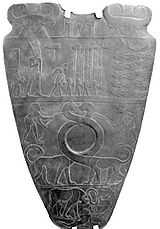Bull Palette
The Bull Palette is an ancient Egyptian palette in the corpus of iconographic cosmetic palettes that focus on topics from the Late Predynastic Period, ca late 4th millennium BC.
Some of the various palettes in the corpus, Narmer Palette, Libyan Palette, Hunters Palette, Min Palette, etc. contain forerunner iconography, or actual hieroglyphs of the Egyptian hieroglyph language.
|
The palette
The Bull Palette-(remainder piece), about 10 inches (25 cm) is made of mudstone or schist, and is etched in more atypical medium, to medium-low relief. A presumed 'fortified city' on the front in the upper register has a major loss of the city-rectangle on upper left showing this medium-level bas relief. The register below appears to be a smaller area of the palette, and has the remains, (about 1/4), of a second fortified city; a bird is one identifier in the city-fortified interior, with the rest missing.
Bull Pallette front
The front of the Bull Pallette has the top left iconography of the Bull overpowering a Warrior. The right half is missing, with a probable second bull facing the first, as part of the upper borders, the left and the right.
The rest of the front contains a large "fortified-walled-city", and is identified in the center with a "larger-lion-and-'Nu'-(vessel); a smaller register section below contains the upper left quarter of a 2nd fortified-city. The 2nd city is of smaller size than the upper register identified city.
Bull Pallette reverse
The reverse has the same Bull overpowering a Warrior-(reversed).
A rope appears to encircle, or is at least part of the entire reverse, as one of the reverse motifs. The remaining piece-(of this Bull Palette) has possibly one of the more important motifs preserved in the palettes corpus. Five standards are shown collectively on the palettes right, and each is an iat standard (hieroglyph), but notably the base of each standard transforms into a 'clenched hand', which embraces the large-diameter encircling rope.
The five standards are:
- A hippopotamus with open mouth
- A hippopotamus with open mouth
- The "Sacred Ibis"
- The standing Horus-Hawk
- Symbol: "Thuderbolt of Min"-(an encircled snake on standard?)
Bull motif; fortified city motif

The motifs of the palette are presumably the Bull overpowering an Enemy, the named-fortified-cities, war-scenes, a collection of gods supporting the war-scenery-(on standards).
The palette's reverse contains only two other clues to the entire scene. The encirling rope has the Bull, and defeated Warrior, (and another presumed pair on left), and two other portions of warriors. Open space (field?) covers space as large, or larger than the two warrior portions. A warrior's leg is shown and is partially fractured-out (chipped), from the bas relief-(the knee portion); adjacent and below the leg, is a perfectly preserved warrior head, with eye, ear, beard, necklace cord, and a "stylized hairdo"-(close cropped).
-

Bull overpowering warrior motif-(Narmer Palette)
-

Narmer Palette: A glyph above left-warrior, (similar to a fortification compound?)
See also
| Wikimedia Commons has media related to Ancient Egyptian palettes. |
- Cosmetic palette
- Gardiner's Sign List
References
- ↑ Wilkinson, Reading Egyptian Art, Clenched Hand, pp 54-55.
- ↑ Wikimedia Commons: "iat-Standard"
- Wilkinson, Reading Egyptian Art, A Hieroglyphic Guide to Ancient Egyptian Painting and Sculpture, c 1992a; Thames and Hudson, with 450 Illustrations.
